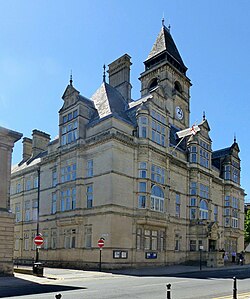Wakefield Town Hall
| Wakefield Town Hall | |
|---|---|
 Wakefield Town Hall | |
| Location | Wakefield,West Yorkshire |
| Coordinates | 53°41′02″N1°30′05″W/ 53.6838°N 1.5014°W |
| Built | 1880 |
| Architect | Thomas Edward Collcutt |
| Architectural style(s) | Gothic style |
Listed Building– Grade I | |
| Designated | 30 March 1971 |
| Reference no. | 1258995 |
Wakefield Town Hallis a municipal building in Wood Street inWakefield,West Yorkshire,England. It remains a venue for weddings and civil partnerships but is no longer the headquarters ofWakefield Councilwhich is now based atCounty Hall.The town hall is aGrade Ilisted building.[1]
History[edit]
The building was commissioned to replace theOld Town Hallin Crown Court which had been completed in 1800.[2]After deciding that the old town hall was of insufficient status to compete withLeeds Town HallandBradford City Hall,civic leaders chose to procure a new town hall:[3]the site they selected was a vacant area between themechanics instituteand the oldCrown Court.[4]
The foundation stone for the new building was laid by the mayor, Alderman William Henry Gill, in October 1877.[3]It was designed byThomas Edward Collcuttin theGothic style,built by William Holdsworth ofBradfordand was officially opened by the new mayor, Alderman William Hartley Lee, in October 1880.[1][5]The design involved a symmetrical main frontage with three bays facing onto Wood Street; the central section, which slightly projected forward, featured a doorway with anentablatureandpedimentand a balcony above; there were ornateoriel windowson the first floor and pedimented bay windows on the second floor and a steeply pitched roof above.[1]A 59 metres (194 ft) high, six-stageclock towerwas erected at the north corner of the building,[6]housing an hour-striking clock byWilliam Potts & Sons.[7]The hour bell, weighing 50cwt,was manufactured byTaylor of Loughborough(they also provided twoquarter bells,[8]but these were scrapped in 1948 having never been connected to the clock).[7]Internally, the principal rooms were the council chamber, the mayor's parlour and the courtroom.[1]
The construction also involved the creation of a tunnel which linked the courtroom and the police cells in the basement of the town hall to the police station in Tammy Hall Street.[9]
Following theSecond World War,a plaque was installed in the council chamber in June 1946 to commemorate the council's decision to award theKing's Own Yorkshire Light Infantrythe right to parade through the streets of the city with "drums beating, bands playing, colours flying and bayonets fixed".[10][11]Princess Elizabeth,accompanied by theDuke of Edinburgh,visited the town hall and waved to the crowds from the balcony on 27 July 1949.[12][13]
The building was the headquarters of theCounty Borough of Wakefielduntil 1974 when it became the local seat of government for the enlargedWakefield Metropolitan District.[14]However, in December 1987, Wakefield Council decided to acquire and refurbishCounty Hall,which was empty and deteriorating, and make County Hall its headquarters.[15]Following an extensive refurbishment of various parts of the town hall in 2016,[16]the council chamber was re-opened as the "Kingswood Suite", for use by the local Register Office as a venue for weddings and civil partnerships.[17]The old courtroom was also made available for use as a reception room.[18]
See also[edit]
References[edit]
- ^abcdHistoric England."Town Hall (1258995)".National Heritage List for England.Retrieved12 November2020.
- ^Historic England."Old Town Hall, Wakefield (1259842)".National Heritage List for England.Retrieved12 November2020.
- ^ab"Wakefield Town Hall".Archiseek.Retrieved12 November2020.
- ^"Ordnance Survey Map".1851.Retrieved12 November2020.
- ^"About T. E. Collcutt, Architect".The Building News and Engineering Journal. 3 January 1890.Retrieved12 November2020.
- ^"Wakefield Town Hall".Skyscraper News.Retrieved12 November2020.
- ^abPotts, Michael S. (2006).Potts of Leeds: Five Generations of Clockmakers.Ashbourne, Derbyshire: Mayfield Books. p. 73.
- ^Snowdon, Jasper W. (1888).Grandsire: the Method, Its Peals, and History.London: Wells Gardner, Darton & Co. p. 207.
- ^Trickett, Kevin (11 September 2020)."An introduction to Wakefield Town Hall".Heritage Open Days.Retrieved12 November2020.
- ^"Wakefield welcomes The Rifles Regiment".Wakefield Council. 13 September 2018.Retrieved12 November2020.
- ^Markham, Leonard (2005).The Wharncliffe Companion to Wakefield & District: An A to Z of Local History.Wharncliffe Books.ISBN978-1903425893.
- ^"Royal Visit to Wakefield".Omnia.Retrieved12 November2020.
- ^"Royal Visit to Wakefield".Yorkshire and North East Film Archive.Retrieved12 November2020.
- ^Local Government Act 1972. 1972 c.70.The Stationery Office Ltd. 1997.ISBN0-10-547072-4.
- ^"County Hall".Wakefield Council. Archived fromthe originalon 30 January 2010.Retrieved15 August2019.
- ^"Wakefield Town Hall".Magill Painting.Retrieved12 November2020.
- ^"Weddings and Celebrations at Wakefield Town Hall".Experience Wakefield.Retrieved12 November2020.
- ^Thornborrow, Peter; Gwilliam, Paul (2018).Wakefield in 50 Buildings.Amberley Publishing.ISBN978-1445659060.

